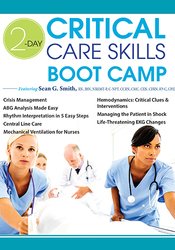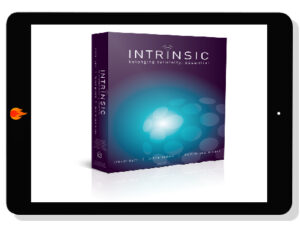Available for Pre-Order. This product will be available within a few days.
 Sean G. Smith – 2-Day Emergency Nursing Boot Camp
Critical Interventions & Actions for:
Trauma’s Lethal Triad
Penetrating Chest Traumas
SIRS & Sepsis
Burn Trauma
Toxicology Challenges
Cardiovascular & Neuro Emergencies
You have the daunting challenge of recognizing subtle changes in a patient’s condition that can lead serious complications or even death. Are you sure you have the knowledge and skills you need to handle these difficult situations?
Working in the rapidly-changing emergency department and caring for the most complex patients means you have to be able to recognize these changes and respond appropriately. You’re dealing with life-threatening conditions and you need to be up to date on the most current and cutting-edge strategies. During this comprehensive program you will gain the skills you need to manage any situation. Drawing on over 20 years of experience, Sean G. Smith, RN, BSN, NREMT-P, C-NPT, CCRN, CMC, CEN, CFRN, FP-C, CPEN, will challenge you to take your knowledge to the next level!
OUTLINE – DAY ONE
Trauma’s Lethal Triad: Hypothermia, Acidosis & Coagulopathy Hypothermia
Correct Classification of the Trauma Patient
Contributing Risk Factors
Volume Resuscitation
Why, When & How to Use IV Fluids
Acidosis
What is Happening & Why?
Panic Values & Lethal Levels
Oxyhemoglobin Dissociation Curve
Left & Right Curves
Why it Matters
Coagulopathies
Understanding a Very Complex Process
Effect on Body Systems
When it Goes Wrong
DIC: Disseminated Intravascular Coagulopathy
Understanding the Lab Values
CBC, Platelets, PT, PTT, D-dimer, Fibrin
Hemorrhagic Shock
Permissive Hypotension
Damage Control Resuscitation
Putting it All Together
Simple Steps that SAVE Lives
Management & Treatment Options
Burn Trauma
Critical Assessments during the Primary Survey
Key Components of the Secondary Survey
Fluid Resuscitation Formulas
American Burn Association Evaluation Criteria
Treatment Strategies for Chemical, Electrical & Thermal Burns
‘Never Miss’ Clues for Identifying Inhalation Injuries
The Septic Patient
SIRS: Systemic Inflammatory Response Syndrome & SEPSIS
Inflammatory Response: A Good Thing
SIRS: Too Much of a Good Thing
Sepsis & Severe Sepsis: Too Much of a Good Thing Comes to a Bad End
Patient Presentations along the Continuum
Sepsis Surveillance
Emergent Interventions: Time is Tissue
OUTLINE – DAY TWO
Penetrating Chest Traumas
FAST Evaluation & Ultrasound
Pneumothorax
Variations & Identifying Symptoms
Emergency Interventions
Flail Chest
Dos & Don’ts of Initial Management
Special Populations at Risk
Cardiac Tamponade
Thoracotomy in the ED
Cardiovascular Emergencies
Advanced Hemodynamics
SVR: Systemic Vascular Resistance
CVP Monitoring
The Spectrum of Acute Coronary Syndrome
Key Assessments & Interventions for:
Unstable Angina
STEMI
Non-STEMI
Recognizing Arrhythmias
Stable, Unstable and Lethal
Neuro Emergencies: Time is Brain
Concepts of Volume & Pressure
Rapid Neuro Assessment
Critical Interventions for:
TBI
Spinal Cord Injuries
Diffuse Axonal Injury
Toxicology Challenges
Identifying the Toxin
Assessment of Intentional & Unintentional Overdose
ABGs – a Critical Key
Treatment Options: Removing & Reducing Causative Agent
Symptom Management Strategies When There is No Curative Agent
Toxicology Arrhythmias: Expected & Unexpected
Today’s Street Drugs
Would you like to receive  Sean G. Smith – 2-Day Emergency Nursing Boot Camp ?
Life-Threatening Electrolyte Imbalances
Critical Clues for Quick Identification
Panic Values
Interventions that Improve Outcomes
Potential Causes & Treatments
OBJECTIVES
Interpret patterns of ischemia, injury and infarction on a 12-lead EKG.
Discuss cardiac disorders which carry an increased risk for sudden death.
Describe the relationship between ventilation and perfusion.
Identify conditions which would require a chest tube.
Recognize assessment findings in clinical syndromes that may progress rapidly and cause life-threatening conditions.
Define the anatomy and physiology of the neurological system and how this manifests in physical symptoms.
Recognize life-threatening electrolyte imbalances, potential causes and remedies.
Interpret arterial blood gasses using a three-step method.
Compare and contrast the oxyhemoglobin dissociation curve to pulse oximetry readings, So2 and pO2 values.
Evaluate signs, symptoms and treatment modalities for four different classifications of shock.
Describe systemic inflammatory response syndrome and the spectrum of septic shock.
Correlate clinical presentations of patients during the continuum of SIRS to septic shock.
Discuss the coagulation cascade and laboratory values associated with disruption of normal function.
ADA Needs
We would be happy to accommodate your ADA needs; please call our Customer Service Department for more information at 1-800-844-8260.
Satisfaction Guarantee
Your satisfaction is our goal and our guarantee. Concerns should be addressed to: PO Box 1000, Eau Claire, WI 54702-1000 or call 1-800-844-8260.








